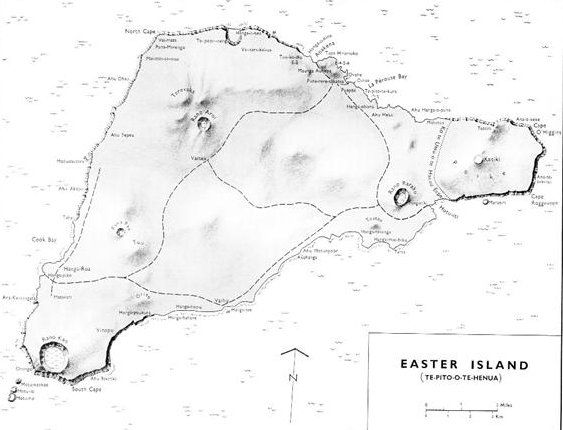1. Volume II of Dream Voyager has as its subject matter a hasty introduction to the timespace of Easter Island, a necessary prelude before we can get anywhere with an outline dictionary of the rongorongo signs. Volume II is furthermore a continuation of my struggle to delineate the unknown southern world of myth ('Terra Australis Incognita'), a world which still ruled on Easter Island when the rongorongo tablets were inscribed. My conviction is that it will not be possible to explain the meaning of the glyphs unless we try to use the traces of the forgotten common mythic lore of yesterday. When Spain took possession of Easter Island in the year 1770 this global mythic language had not yet been completely forgotten by them: "On the following day, 20 November 1770, Commander José Bustillo took formal possession of Easter Island 'in the name of the King and of Spain, our Lord and Master Don Carlos the third', renaming the island 'San Carlos'. Several hundred Rapanui - probably members of the Koro 'o 'Orongo tribe of the eastern 'Otu 'Iti - observed the ceremony not far from Poike's parasitic cones Parehe, Teatea, and Vai 'a Heva, on the tops of which the Spaniards had planted three crosses. Following three boisterous 'Viva el Rey!' for each cross, the land party let off three salvos of musketry, whereupon the two Spanish vessels San Lorenzo and Santa Rosalia responded with 21 cannon salutes. Spain's foremost historian of the Pacific, Francisco Mellén Blanco, has written of the event: 'The spectacle must have been awe-inspiring for the islanders. The parade of uniformed soldiers; the fluttering flags; the chaplains in their surplices chanting out the litany; the beating of drums, and the trilling of fifes must have left a lasting impression on all the natives who witnessed the procession' ..." (Fischer) 3 * 3 = 9 musketry salvos ought to mean the end of the previous reign (even a cat has no more than 9 lives). The following salute from the pair of ships with 21 cannon shots - one more than 20 - was to indicate the beginning of something new. The beating of drums and other noise, and the ceremonies, were there to wake up this new era. In Makoi's list beating of drums (rutu) was mentioned late:
The choice of place is what most interests me, because the 3 cones inside the northeastern corner of the island (named Teatea on the map below), are opposite to the 3 islets outside the southwestern corner of the island:
The ruler of the land should represent Sun and he is born in the northeast. In the southwestern corner of the island are 3 islets followed by Rano Kau and in the northeastern corner is Rano Raraku followed by 3 mountain tops. Certainly this symmetric arrangement must have had a place is the mythic timespace landscape of the island. Moon rules the southern coastline and her place of birth is Rano Kau. She grows older while moving towards Poike. Sun rules the land beyond Teatea, which name could be a negation of tea, the white of Moon. Rauoho teatea means red hair:
|
